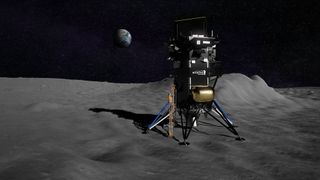
An illustration of the private Nova-C moon lander built by Intuitive Machines on the lunar surface.
(Image credit: Intuitive Machines)
A private lunar lander has taken another step toward its historic moonshot.
The robotic Nova-C spacecraft was encapsulated inside the payload fairing of its SpaceX Falcon 9 rocket today (Jan. 31) to prep for liftoff, which is right around the corner.
“As our combined teams closed the two fairing halves, I saw the lunar lander for the last time on Earth,” Trent Martin, vice president for space systems at the Houston company Intuitive Machines, which built the lander, said during a call with reporters this afternoon.
Launch, from Cape Canaveral Space Force Station on Florida’s Space Coast, will occur during a three-day window in mid-February, if all goes according to plan. SpaceX and Intuitive Machines have not yet announced what those dates are, though Martin said today that Nova-C’s lunar landing try will take place on Feb. 22 regardless of which day it takes flight.
If launch cannot occur during the February window, the next opportunity will come in March.
Related: Moon mining gains momentum as private companies plan for a lunar economy
The coming mission, called IM-1, aims to put Nova-C down near an impact crater called Malapert A, which lies within 10 degrees latitude of the moon’s south pole. This area is of great interest to scientists and exploration advocates, for it’s thought to harbor large amounts of water ice.
IM-1’s Nova-C lander, which Intuitive Machines named Odysseus, is carrying six NASA science instruments via the agency’s Commercial Lunar Payload Services program, or CLPS for short. CLPS aims to leverage private robotic landers to help gather science data that will pave the way for a permanent human presence on and around the moon, which NASA is working toward with its Artemis program.
IM-1’s NASA instruments include a laser-based descent and landing sensor, a camera system designed to capture in great detail the plume created by Odysseus’ lunar touchdown and a new type of “space-age fuel gauge,” which will use sensors to measure the amount of propellant left in the lander’s tanks — a challenging task in the microgravity environment.
“Future spaceflight missions using cryogenic propellants can potentially take the guesswork out of monitoring propellant reserves and save fuel by using this technology,” Debra Needham, program scientist in the Exploration Science Strategy and Integration Office at NASA headquarters, said in today’s briefing.
Odysseus is also carrying six commercial payloads on IM-1, for a variety of customers. You can learn more about the mission via Intuitive Machines here.
Nova-C won’t be the first CLPS-supported lunar lander to lift off. That distinction went to Astrobotic’s Peregrine spacecraft, which launched Jan. 8 on the first-ever mission of United Launch Alliance’s new Vulcan Centaur rocket.
Vulcan Centaur performed well, but Peregrine suffered a crippling fuel leak shortly after deploying from the rocket’s upper stage. The lander’s handlers managed to keep it operating in deep space for 10 days, eventually steering it to a controlled destruction in Earth’s atmosphere on Jan. 18.
So Odysseus could become the first private spacecraft ever to ace a lunar landing. Success would keep the moon milestones rolling in; on Jan. 19, the robotic SLIM lander survived its rocky landing attempt, making Japan just the fifth country to put a probe on the moon’s surface. The other four nations are the Soviet Union, the United States, China and India.
Join our Space Forums to keep talking space on the latest missions, night sky and more! And if you have a news tip, correction or comment, let us know at: [email protected].
Breaking space news, the latest updates on rocket launches, skywatching events and more!
Michael Wall is a Senior Space Writer with Space.com and joined the team in 2010. He primarily covers exoplanets, spaceflight and military space, but has been known to dabble in the space art beat. His book about the search for alien life, “Out There,” was published on Nov. 13, 2018. Before becoming a science writer, Michael worked as a herpetologist and wildlife biologist. He has a Ph.D. in evolutionary biology from the University of Sydney, Australia, a bachelor’s degree from the University of Arizona, and a graduate certificate in science writing from the University of California, Santa Cruz. To find out what his latest project is, you can follow Michael on Twitter.
>>> Read full article>>>
Copyright for syndicated content belongs to the linked Source : Space.com – https://www.space.com/spacex-intuitive-machines-nova-c-moon-lander-launch-preparations































